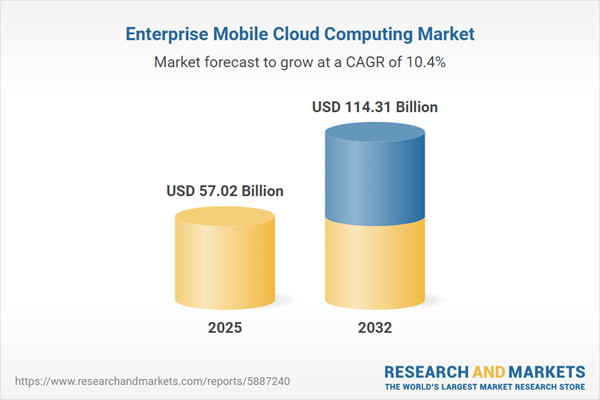Speak directly to the analyst to clarify any post sales queries you may have.
Enterprise mobile cloud computing is fundamentally transforming how organizations drive operational efficiency and digital innovation by integrating mobile and cloud capabilities across distributed environments. This report provides senior decision-makers with a concise, actionable assessment of enterprise mobile cloud strategies, major growth drivers, and evolving trends.
Market Snapshot: Enterprise Mobile Cloud Computing Market Trends
The Enterprise Mobile Cloud Computing Market grew from USD 51.67 billion in 2024 to USD 57.02 billion in 2025. With a projected CAGR of 10.43%, this market is expected to reach USD 114.31 billion by 2032. Rapid advancements in connectivity, edge processing, and mobile device capabilities are fueling robust adoption. Organizations across industry verticals are adopting these solutions to achieve responsive application delivery, elevate user experience, and support workforce mobility while addressing security and regulatory priorities.
Scope & Segmentation
This report delivers in-depth analysis and forecasting across a broad spectrum of segments and geographies, reviewing both established and emerging technologies in enterprise mobile cloud computing.
- Deployment Models: Hybrid cloud, on-premise, private cloud, and public cloud each present unique integration, control, and compliance features that influence enterprise choices.
- Service Models: Infrastructure as a Service, Platform as a Service (including container and function-based offerings), and Software as a Service enable scalability and streamlined resource management across various use cases.
- Enterprise Sizes: Large enterprises leverage multi-tiered architectures, while small and medium organizations prioritize rapid deployment and lower complexity.
- Industry Verticals: BFSI, healthcare, IT and telecom, manufacturing, and retail impose distinct compliance, interoperability, and performance requirements shaping adoption patterns.
- Device Types: Smartphones, tablets, and wearables introduce diverse endpoint management and application design challenges.
- Regions Covered: Americas (North America, Latin America), Europe, Middle East & Africa (UK, Germany, France, Russia, Italy, Spain, Netherlands, Sweden, Poland, Switzerland, UAE, Saudi Arabia, Qatar, Turkey, Israel, South Africa, Nigeria, Egypt, Kenya), and Asia-Pacific (China, India, Japan, Australia, South Korea, Indonesia, Thailand, Malaysia, Singapore, Taiwan).
- Leading Companies Profiled: Amazon.com, Inc.; Microsoft Corporation; Google LLC; Alibaba Group Holding Limited; International Business Machines Corporation; Oracle Corporation; Salesforce, Inc.; SAP SE; VMware, Inc.; Cisco Systems, Inc.
Key Takeaways for Senior Decision-Makers
- Enterprise mobile cloud computing is enabling organizations to deliver secure, responsive, and scalable applications, driving operational excellence and digital transformation.
- Hybrid and multi-cloud strategies help balance data sovereignty, flexibility, and compliance, making them an optimal choice in complex regulatory landscapes.
- Edge deployments and containerized architectures support real-time analytics and foster greater agility, especially as latency-sensitive applications proliferate.
- Zero trust security frameworks and advanced encryption are increasingly integrated to address expanding threats and regulatory requirements.
- Vendor strategies emphasize industry-specific solutions, partnerships, and managed services to meet unique organizational and market needs.
Tariff Impact and Supply Chain Considerations
Recent United States tariffs have prompted organizations to reassess hardware sourcing, elevate supplier diversification, and rethink procurement strategies. Both buyers and cloud service providers are innovating towards cost-effective, software-defined endpoints and flexible architectures. This adaptation is strengthening supply chain resilience and supporting long-term price predictability for enterprise buyers.
Methodology & Data Sources
The analysis integrates primary interviews with senior IT leaders and experts, along with secondary research from reputable industry reports, regulatory filings, and thought leadership presentations. Quantitative surveys across multiple regions validate emerging trends, while expert roundtables deepen contextual insights within the enterprise mobile cloud computing landscape.
Why This Report Matters
- Provides senior leaders with strategic insights to identify high-impact investment opportunities in mobile cloud solutions.
- Delivers vendor and technology benchmarks to guide sourcing, compliance, and deployment decisions.
- Offers in-depth segmentation and regional perspectives to tailor technology adoption and competitive strategy in dynamic markets.
Conclusion
Integrated mobile cloud strategies underpin enterprise readiness, operational agility, and risk management. This comprehensive report equips decision-makers with a pragmatic foundation for leveraging mobile cloud computing to sustain growth and competitive advantage.
Additional Product Information:
- Purchase of this report includes 1 year online access with quarterly updates.
- This report can be updated on request. Please contact our Customer Experience team using the Ask a Question widget on our website.
Table of Contents
3. Executive Summary
4. Market Overview
7. Cumulative Impact of Artificial Intelligence 2025
Companies Mentioned
The companies profiled in this Enterprise Mobile Cloud Computing market report include:- Amazon.com, Inc.
- Microsoft Corporation
- Google LLC
- Alibaba Group Holding Limited
- International Business Machines Corporation
- Oracle Corporation
- Salesforce, Inc.
- SAP SE
- VMware, Inc.
- Cisco Systems, Inc.
Table Information
| Report Attribute | Details |
|---|---|
| No. of Pages | 199 |
| Published | November 2025 |
| Forecast Period | 2025 - 2032 |
| Estimated Market Value ( USD | $ 57.02 Billion |
| Forecasted Market Value ( USD | $ 114.31 Billion |
| Compound Annual Growth Rate | 10.4% |
| Regions Covered | Global |
| No. of Companies Mentioned | 11 |









